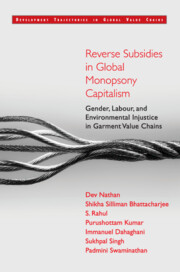 Reverse Subsidies in Global Monopsony Capitalism
Reverse Subsidies in Global Monopsony Capitalism 8 - The Household as a Production Site: Homeworkers and Child Labour
Published online by Cambridge University Press: 21 January 2022
Summary
So far, we have dealt with the household as a site for the reproduction of labour power. However, the household is also a site for production to perform tasks outsourced from the factories. There are two types of home-based workers. First, those who buy inputs, perform some value-adding tasks, and sell the output. These are called either own-account workers or self-employed workers. Street vendors and hawkers are of this type who operate on their own account. The second type of home-based worker constitutes those who perform tasks specified by an employer. Women in Informal Employment, Globalizing and Organizing (WIEGO), the international network of women in the unorganized sector, refers to this type of home-based workers as homeworkers, and this terminology will be followed here.
The ILO Convention 177 on Home Work defines home work as
work carried out by a person, to be referred as a homeworker, (1) in his or her home or in other premises of his or her choice, other than the workplace of the employer; (2) for remuneration; (3) which results in a product or service as specified by the employer, irrespective of who provides the equipment, material or other inputs used unless this person has the degree of economic independence necessary to be considered an independent worker under national laws, regulations or court decisions. (ILO 2000, emphasis added)
Since we are considering sites of production, it is important to note that to qualify as homework, work must be carried out on a site ‘other than the workplace’ and carried out ‘as specified by the employer’. Since homework is carried out as specified by the employer, it qualifies as part of the global value chain (GVC), where work contracted to the manufacturer of garments is outsourced to a homeworker. The relation between the manufacturer, the exporter, and the homeworker is not of the market type where the homeworker sells goods or services to the manufacturer. Rather, the manufacturer contracts for the performance of tasks, usually embroidery or finishing an almost-finished garment.
These subcontracted homeworkers occupy an intermediate space between independent own-account workers and factory workers (Raveendran, Sudarshan, and Vanek 2013). They differ from own-account workers in that they are not sellers of their output. The finished pieces of work are returned to the factory, via the contractor, and the homeworkers are paid for the tasks performed.
- Type
- Chapter
- Information
- Reverse Subsidies in Global Monopsony CapitalismGender, Labour, and Environmental Injustice in Garment Value Chains, pp. 154 - 164Publisher: Cambridge University PressPrint publication year: 2022


